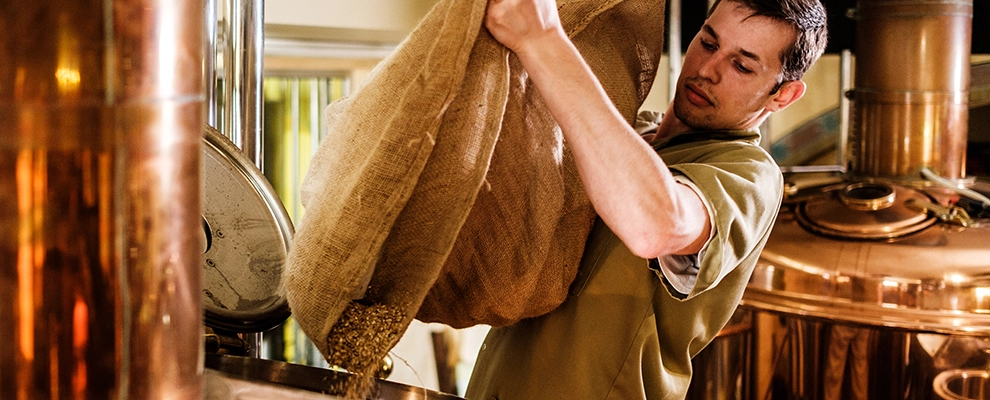Dry hopping, also known as "hopfenstopfen", has become one of the most important techniques in modern brewing – especially in the craft beer scene. The aim is to give the beer intense hop aromas without significantly increasing the bitterness. But what exactly is behind the process, when is the ideal time for dry hopping, and which hop varieties are particularly suitable?
In this article we’ll show you in practical terms how dry hopping works, what variants there are, and with which hops you can achieve the greatest aromatic effect.
What Is Dry Hopping and Why Is It Important?
Dry hopping is an artful technique that decisively shapes the character of beers. By adding hops during secondary fermentation, the aroma is intensified while the bitterness remains largely unchanged. This method allows brewers to experiment with different hop varieties to create unique flavors and scents. Choosing suitable hops is particularly important; varieties like Citra, Mosaic or Galaxy deliver intense citrus and tropical fruit notes that stand out especially well.
Typical goals of dry hopping:
- Enhancement of hop aroma without additional bitterness
- Fresh, grassy or fruity character
- Increased complexity in the aromatic spectrum
Hop form: Type 90 hop pellets or whole cones are especially suitable.
The Dry Hopping Technique: How It Works
Dry hopping is an art that allows the aroma and taste of beer to be taken to the next level. In this technique, hops are added during fermentation or after boiling so that the aromas can unfold without the bitterness becoming overpowering. It is important to carefully choose the hop varieties, as different varieties produce different flavor profiles and aromas. The addition typically occurs after primary fermentation to preserve the freshness and intensity of the essential oils. The amount of hops used also plays a big role; too much can disrupt the balance of the beer. To achieve optimal results, brewers should also pay attention to the temperature, as cool conditions preserve the aromatic substances better. Mistakes such as adding hops too early or too late can reduce the desired effect. With precise technique and timing, you can transform your beer into an aromatic masterpiece.
The Best Time for Dry Hopping
Different stages in the brewing process offer different results when it comes to dry hopping:
1. Primary Fermentation (active fermentation):
- Advantage: CO2 helps to displace oxygen (oxidation protection)
- Disadvantage: Loss of volatile aroma substances possibleSome aroma compounds may be lost
2. Secondary Fermentation (after primary has finished):
- Advantage: full aroma extraction with little aroma loss
- Duration: 3–7 days at approx. 16 °C recommended
3. Cold Crashing (lagering):
- Advantage: Clarity and freshness
- Disadvantage: reduced extraction due to low temperatures
Tip: Experiment with different times and methods to find out which one works best for your personal style. Some brewers also use a combination of early and late hop additions (double dry hopping). This allows for a multilayered aroma formation and enhances the freshness of the beer. Also note the temperature, as warmer beer releases the aroma substances better.
The best hop varieties for dry hopping
Selecting the right hop varieties for dry hopping is crucial as they significantly shape the aroma and taste of your beer. Not all hops are equally well suited for dry hopping. Particularly aroma-intensive, modern flavour and aroma hop varieties are ideal. Here is a selection of recommended varieties:
- Columbus hops – powerful, spicy, with notes of orange & lemongrass
- Mandarina Bavaria – fruity with pineapple, cassis & citrus
- Saphir hops – complex with tea, strawberry & citrus
- Vic Secret™ hops – tropical with grapefruit, strawberry & pineapple
Also recommended are Amarillo and Nelson Sauvin, which bring exotic aromas into play. It is important to pay attention to the freshness of the hops, as older varieties may provide less intense aroma. You should also vary the amount of hops to achieve a balanced flavor profile.
Tips for successful application
- Dosage: 2–5 g hops per liter of beer is common
- Contact time: no longer than 5–7 days – otherwise grassy off-flavors may occur
- Avoid oxygen: open fermentation vessel only under CO2 pressure
- Pellets vs. cones: Pellets offer better extraction, cones more “authentic” aroma
Common mistakes in dry hopping and how to avoid them
Various errors can occur during dry hopping that negatively affect the final product. A common stumbling block is the incorrect dosing of the hop quantity. Too much hop can make the beer overwhelmingly bitter, while too little does not unfold the desired aroma. The timing also plays a crucial role; if the hops are added too early, the aroma may be lost. The choice of hop varieties is also critical. Some varieties harmonize better and unfold complex aromas, while others may clash or produce unpleasant flavors. It is also important to pay attention to hygiene aspects. Unsanitary equipment or environments can contaminate the beer and impair its taste. A clean and structured approach to dry hopping is essential to bring out the desired aromas optimally. By keeping these points in mind, you increase the chances of producing an aromatic and well-balanced beer.
Dry hopping is a simple yet effective method of giving beers a modern, fresh aroma profile. Whether Pale Ale, IPA, Helles or Lager: The right hop at the right time makes the difference.
In our online shop you will find high-quality aroma hops, flavour hops and special varieties – perfect for your dry hopping creations.

